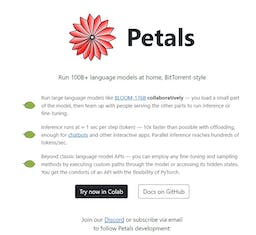User's Area

Petals
Open source tool for running LLMs collaboratively
What is Petals?
Open source tool for Collaborative Execution of Large Language Models
An open source tool has been developed to enable the collaborative execution of large language models, such as BLOOM-176B. This tool allows users to load a small section of the language model and then collaborate with others who are responsible for serving the remaining portions in order to perform tasks such as inference or fine-tuning of the model.
Collaborative Execution of Large Language Models
The tool is designed to address the challenges posed by the immense size of models like BLOOM-176B, which are too large to be loaded and executed by a single user or machine. By splitting the model into smaller portions and enabling collaboration among individuals or teams, the tool provides a practical solution for leveraging these large language models effectively.
Breaking Down the Model
Users of the tool can access and load a small part of the large language model, with the remaining sections being served by others who are part of the collaborative effort. This approach allows for the distribution of processing and computational resources, making it feasible to handle the inference and fine-tuning tasks associated with the sizable language model.
Utilizing Teamwork for Model Execution
The collaborative nature of the tool encourages users to work together to effectively execute the large language model. By dividing the model and coordinating the execution among multiple individuals or teams, the tool enables efficient utilization of resources while also promoting teamwork and cooperation in the execution of complex language models.
Enabling Inference and Fine-Tuning
With the capability to load a section of the large language model and collaborate with others who possess the remaining sections, users of the tool can engage in various tasks such as inference and fine-tuning. The collaborative execution approach not only facilitates the efficient handling of these tasks but also emphasizes the value of teamwork in working with large language models.
Conclusion
The development of this open source tool for collaborative execution of large language models represents a significant advancement in the field of natural language processing. By breaking down the model and enabling collaboration, the tool offers a practical means of leveraging enormous language models like BLOOM-176B for inference and fine-tuning, ultimately promoting cooperation and efficient resource utilization in the execution of these complex models.
Petals Details
- Links
- Visit Website
- Discord
- GitHub
- Plans and Pricing
- Open Source
- Topics
- LLM
- Tags
- #petals ai